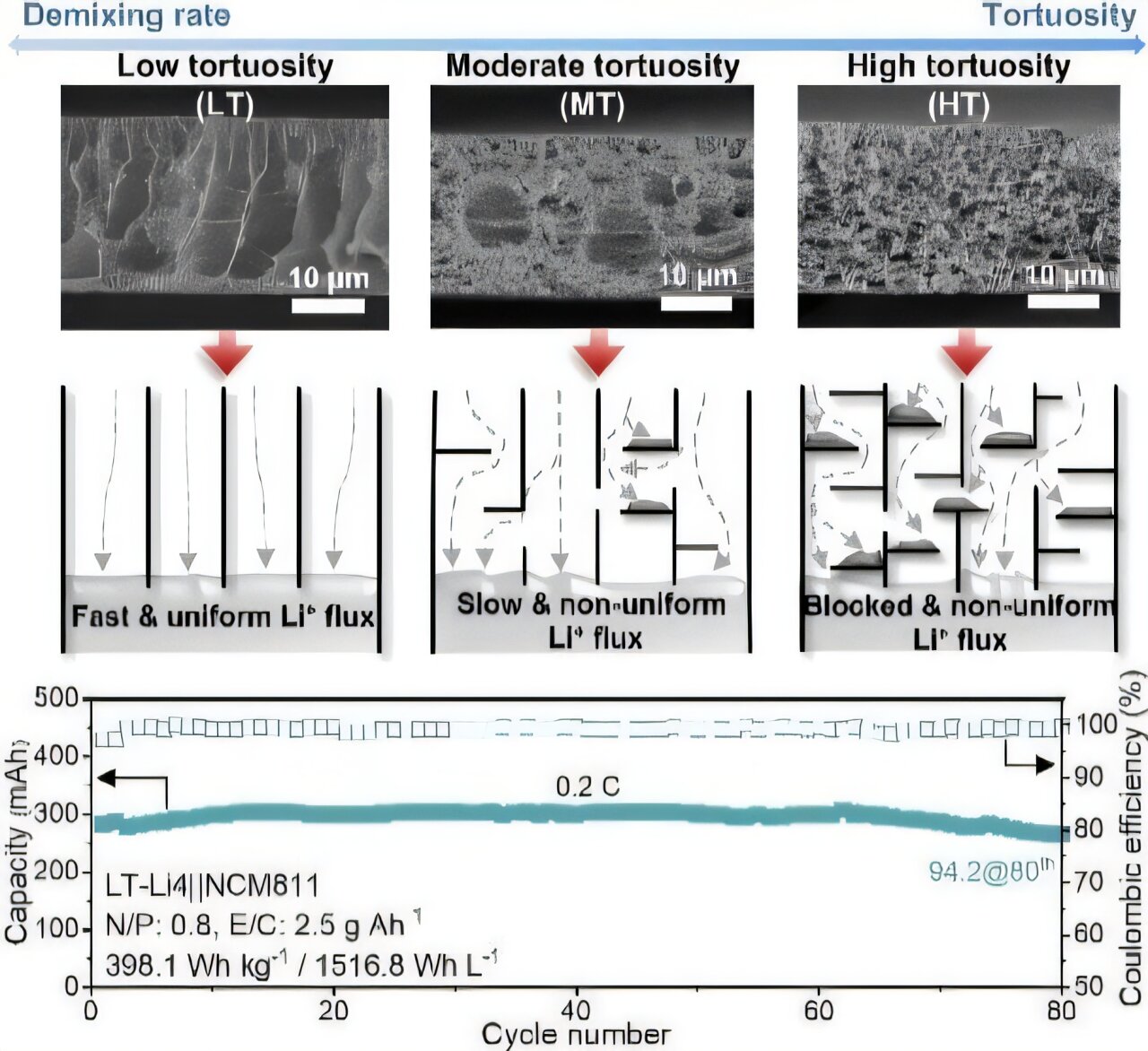
According to the International Council on Clean Transportation, as of early 2024, there are approximately 40 million electric vehicles (EVs) in operation worldwide. Among them, verified battery-related fires in light-duty EVs number just over 500 between 2010 and mid-2023, corresponding to a fire risk of roughly 1 in 100,000 vehicles.
While this rate is substantially lower than that for internal-combustion-engine vehicles, EV battery fires remain a major concern because once thermal runaway occurs and a fire ignites, they can be extremely difficult to extinguish and may reignite.
A research team from POSTECH (Professor Soojin Park, Dr. Dong-Yeob Han, Gayoung Lee) and Chung-Ang University (Professor Janghyuk Moon, Seongsoo Park) has developed a novel three-dimensional porous structure that significantly improves both the lifespan and safety of lithium-metal batteries (LMBs). Their work is published in Advanced Materials.
Lithium metal batteries promise much higher energy density than today’s lithium-ion batteries and could dramatically extend EV driving range. However, the main barrier to commercialization has been the tendency of lithium metal to deposit unevenly during charging and discharging, forming needle-like “dendrites” that can pierce separators and cause internal short-circuits or even explosions.
The team’s solution is simple yet effective: they engineered a porous host structure with straight, low-tortuosity channels and a built-in lithiophilicity gradient enabling uniform lithium deposition from the bottom up. Think of a parking garage: if the entrance is narrow and lanes are winding, cars tend to bunch at the entrance. But if you build wide straight ramps and make lower floors more spacious, vehicles naturally fill the lower floors first. Their electrode design applies this principle to lithium ions in the battery.
Using a nonsolvent-induced phase separation (NIPS) process, they created the porous host by mixing a polymer matrix with carbon nanotubes (CNTs) and silver (Ag) nanoparticles to enhance electrical conductivity, while introducing an Ag layer on a copper substrate to induce lithium nucleation at the base. As a result, bottom-up lithium deposition with fully suppressed dendrite growth and greatly improved structural stability.
In tests, batteries built with this host achieved an energy density of 398.1 Wh/kg and 1,516.8 Wh/L, far exceeding typical lithium-ion batteries (~250 Wh/kg, ~650 Wh/L). Even under commercial-level conditions with low electrolyte content, a thin lithium anode, and real-world cathodes such as NCM811 and LFP, they demonstrated outstanding stability without short circuits or capacity collapse. If applied to EVs, this improvement could potentially extend driving range by roughly 60–70% (for example, a vehicle that currently travels ~400 km per charge might reach ~650–700 km).
Professor Park stated, “This research presents a new way to simultaneously control ion transport pathways and lithium growth behavior inside electrodes, without relying on complex manufacturing processes. Designing both the ‘path’ and the ‘direction’ of lithium movement will be a turning point in advancing toward the commercialization of safe, high-energy lithium-metal batteries.”
Professor Moon added, “Our process allows simultaneous control of microstructure and chemical gradients through a simple fabrication route, making it highly scalable for industrial production.”
More information:
Gayoung Lee et al, Regulating Polymer Demixing Dynamics to Construct a Low‐Tortuosity Host for Stable High‐Energy‐Density Lithium Metal Batteries, Advanced Materials (2025). DOI: 10.1002/adma.202510919
Pohang University of Science and Technology
Citation:
3D porous structure promises safer, longer-lasting lithium-metal batteries for electric vehicles (2025, October 31)
retrieved 31 October 2025
from https://techxplore.com/news/2025-10-3d-porous-safer-longer-lithium.html
This document is subject to copyright. Apart from any fair dealing for the purpose of private study or research, no
part may be reproduced without the written permission. The content is provided for information purposes only.










